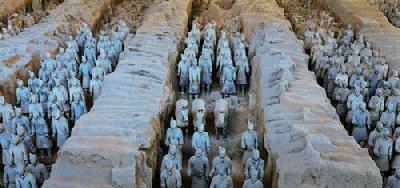Mausoleum of Qin Shihuang and Museum of Terra Cotta Warriors

Built for the first emperor in Chinese history, the mausoleum was listed as a world cultural heritage site in 1987. According to Records of History, Qing Shihuang started building his own tomb on Lishan Mountain soon after he came to the throne. Construction expanded after he unified China in 221 B.C. and involved 700,000 laborers. It was completed 38 years later.
The mausoleum has a square rammed earthen base and is still 76 meters high. The coffin and chamber of Qin Shihuang are in the center of the underground palace. The mausoleum site contains more than 400 tombs and vaults of articles buried with Qin Shihuang; they cover an area of 56.25 square kilometers. The main vaults include the vault of the bronze carriage, the vault of horses, the vault of rare and precious birds and animals, the vault of stables and the vault of warriors and horses. Over the past few years, a total of 50,000 historical and cultural relics have been unearthed. The painted and colored bronze carriage, drawn by two bronze horses unearthed in 1980, is the largest and most elegant of its type discovered in China. The carriage is made of more than 3,000 parts, over 1,000 of them gold and silver.
The vaults of the terra cotta warriors and horses are 1.5 kilometers east of Qin Shihuang′s Mausoleum and the first was discovered when local peasants were sinking wells during a drought in 1974. There are three vaults. Vault I is 14,260 square meters in area and contains 6,000 life-like terra cotta warriors and horses. On display are 1,000 soldiers, eight war chariots and 32 horses. Vault Ⅱ, which covers an area of 6,000 square meters, contains 1,300 warriors and horses and 89 war chariots. Unlike Vault ( which contains only chariots and foot soldiers, Vault Ⅱhouses warriors, war chariots, cavalrymen, and foot soldiers. Vault Ⅲ is the headquarters of the underground army and is 376.64 square meters in area. In it there are 68 warriors, one war chariot and four horses. The figures epitomize soldiers of the Qin army.
Included in the UNESCO world heritage list in 1987.
Source: http://old.cnta.gov.cn